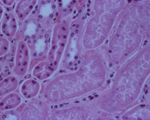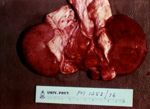Category:Enteritis, Bacterial
Jump to navigation
Jump to search
Colibacillosis
"Pulpy kidney" Disease
- Caused by Clostridium welchii / Clostridium perfringens type D.
- The organisms are found everywhere cannot be got rid of.
- Found in the soil and as a gut commensal, but can explosively multiply and produce toxin under certain conditions.
- Often occurs when the animal had just changed from one feed to another (i.e. just put out onto lush grass).
- Seen mostly in sheep and goats.
- Disease was commonly vaccintated against, but this may not be done in times of financial difficulty.
- Diagnosis of the disease is important in deciding if should sheep be vaccinated.
- If the animal has been vaccinated it is important to need to diagnose pulpy kidney accurately in case of possible legal proceedings.
- Diagnosis of the disease is important in deciding if should sheep be vaccinated.
- Disease was commonly vaccintated against, but this may not be done in times of financial difficulty.
Clinical
- The time course from onset to death is only a few hours, so sheep are normally found dead and only occasionally seen alive.
- Nervous signs, such as head pressing, may be seen.
- Paralysis of the oesophagus may result in severe bloat.
- Profuse greenish diarrhoea is seen occasionally just before death.
- Only mild catarrhal enteritis is seen in the gut.
Pathogenesis
- Lesions due to effect of epsilon toxin on blood vessels.
Pathology
- Animals are very bloated.
- Often lack lesions.
- Guts appear slightly flaccid, and a bit hyperaemic.
- The toxaemic carcase has petechial and echymotic haemorrhages, and hydropericardium.
- The kidneys are characteristically affected.
- Become oedematous, mushy and red within about 1 hour of death.
- A stream of water on cut surface of the kidney washes away the epithelium (since it is necrotic) and leaves fronds of tissue (This is the case with any kidney if the post mortem is more than a few hours after death).
- This accelerated post mortem change is a characteristic of the disease.
- Glycosuria is a feature
- The toxin affects the epithelium of the proximal part of nephron, stopping resorption of glucose.
- Note: the swelling of cells in the kidney means that anuria occurs, meaning there is no urine avaialable to rest for glucose.
- It is sometimes possible to get a positive reaction to a stick test by wiping it on the inside of the bladder.
- Periportal hepatic fatty change occurs.
- This is only really seen histologically.
- Grossly, the liver looks "half cooked", but this is true of many bacterial diseases.
- Histopathology is often not helpful.
- Necrosis of cells in proximal convoluted tubules.
- There is also a characteristic degeneration in parts of the brain - focal symmetrical encephalomalacia
Diagnosis
- Location of the organism in the gut contents is not helpful, since it is always present (as a commensal).
- Therefore, diagnosis is by location of the toxin in the gut contents.
- Toxin is tested for by administering filtered intestinal fluid intravenously to a mouse (mouse protection test).
- If the toxin is present, the mouse should die within minutes or hours.
- Another mouse can be protected from the effect of the toxin with a specific antibody.
- An ELISA test is also possible.
- However, an ELISA is often too sensitive as the toxin can be present in the normal sheep gut and the ELISA can pick this up.
Pages in category "Enteritis, Bacterial"
The following 16 pages are in this category, out of 16 total.

